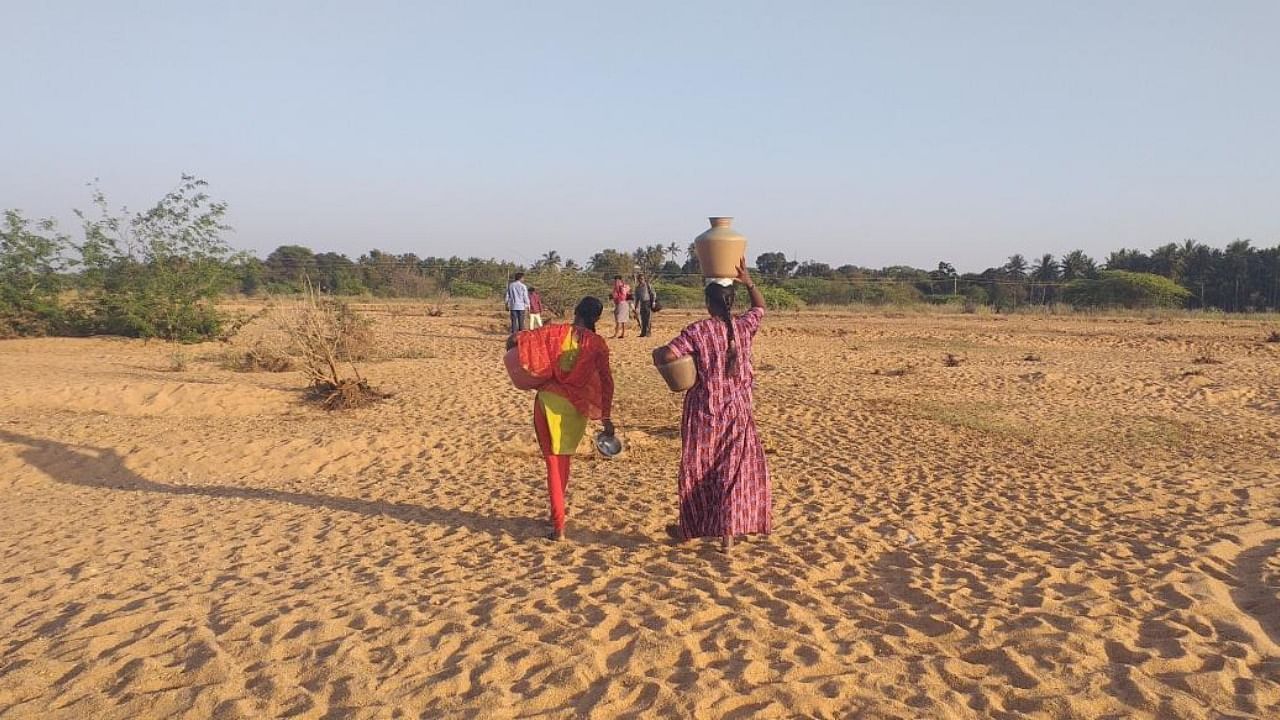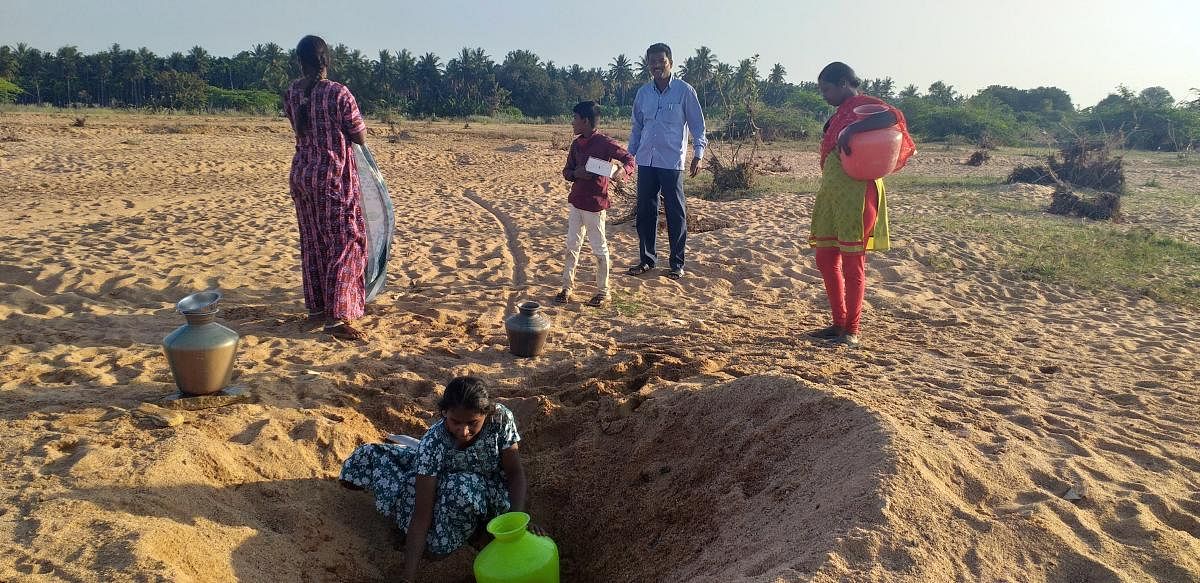

The story of the Jayamangali river is a study in contrast — one of destruction and conservation. While this small river has seen plunderers acquiring the river bed, looting sand and polluting it, it also has communities who are making conscious efforts to protect it. While there are long queues of trucks waiting to be filled with sand, just a few kilometres away, one can see people who dig the river bed to reach a spring and collect water.
Born in the hills of Devarayanadurga in Tumakuru district, Jayamangali joins the Uttara Pinakini at Sangameshwara in Andhra Pradesh before draining into the Bay of Bengal. It flows for about 80 km, passing through Tumakuru, Koratagere and Madhugiri in Tumakuru district in Karnataka and Parigi mandal in Andhra Pradesh. It takes birth in a small valley hidden below the rocks of Devarayanadurga, flows as a small stream and then joins the huge lake at Irakasandra taking the form of a river.
It has two tributaries — Garudachala that flows from Doddaballapur near Kodlahalli in Koratagere taluk and Suvarnamukhi that comes from Siddarabetta close to Akkirampura.
During the days of plenty, farmers on the banks of this river grew paddy, betel leaves, and sugarcane, drawing water from the river to grow crops.
The area was known for its desi varieties of paddy like the Halubbalu, Ghangadale, Coimbatore Sanna, Devamallige, Hamsa and Baroda paddy, and ragi varieties such as Dodda ragi and spiny brinjal.
The Jayamangali was so prosperous that Sir Mirza Ismail, the then Diwan of the erstwhile princely state of Mysore, laid the foundation stone for constructing a anicut across the river near Kyamenahalli on March 21, 1933. This dam made in stone is still intact. King Jayachamarajendra Wadiyar got a bridge constructed across the river near Puravara in Madhugiri taluk on July 30, 1949, to help people cross it.
Pristine river
During the 1970s and '80s, Jayamangali would flow in force for at least two to three months a year. After a season of good rains, all the wells, lakes and talapariges (small springs) would stay recharged throughout the year even if Jayamangali had water for just six months.
In 1985, a reservoir was constructed at Theetha in Koratagere taluk. A few years ago, hundreds of acres of land in the vicinity of the river near Mydanahalli was declared a blackbuck sanctuary
But the river started changing in the 1990s. A river that once quenched the thirst of all villages along its course turned bone dry. The unpredictable rains along with human intervention led to layers of sand going missing. The deep trenches from where sand was mined turned into garbage dumps. While the older generation staying on the river bank protected the river to use the water for agriculture, cattle and drinking, the younger generation continued to sell sand.
The deep scars of such exploitation of the river can be seen at Kodigenahalli in Madhugiri taluk. The bed of the river just beside this village has been dug open to such an extent that water cannot flow even when the area receives good rainfall. The deep trenches have led to the river bank caving in, leaving the fields damaged. Invasive shrubs (seeme jaali) have engulfed these trenches, obstructing the flow of water. Vast tracts of shrubs covering the entire bed of Jayamangali can be seen near Kodigenahalli and near Holavanahalli in Koratagere taluk.
Depleting water table
Naturally, the rapidly depleting underground water table has led to a severe water crisis in the area. Excessive sand mining has led to a change in the entire course of the river near Kodlahalli, where the Garudachala meets Jayamangali.
Another challenge that Jayamangali is facing is illegal acquisition. In some places, those on the banks have illegally acquired and fenced a portion of the river bed to raise coconut and arecanut plantations while in towns, people have raised its beds to set up shops and hotels.
However, the Jayamangali has some well-wishers as well. There are some villages that have voluntarily banned sand mining along the course of the river. Just five to six kilometres from Kodigenahalli, there are villages where people have put a halt on sand mining. Only those who need sand for personal use can carry it in bullock carts. No tractors or trucks can be used to fetch sand.
These villages stood so strong that they did not succumb to pressure by the sand mafia. Narasimhayya of Kalenahalli, Gangadhar of Reddyhalli, Kalyani of Veerapura and others opposed sand mining by courageously blocking the sand-laden trucks. They even dared to lodge complaints against such activities with the police, revenue and mines and geology departments.
Such measures have not only helped in protecting Jayamangali but also helped it rejuvenate.
The water table here has held up even during the worst of droughts and the area has rarely faced drinking water problems. Even if there is no flow of water, people get water by digging a small spring in the river bed. The wells in the area too have good water levels.
“I have been drinking water from these springs since my childhood. This water tastes good,” says Veerabhadrayya of Veerapura.
The year 2021 saw good rains and Jayamangali was seen flowing for a month in November. Even Garudachala river that had been vanishing even in people’s minds came back to life. People say the last time the river was flowing in such a manner was in 1991.
So, 2021 served many lessons. Once the river was full, people would not have any water problems for at least another two to three years.
For this, the rivers must survive. Riverbed acquisition and sand mining must stop.
This is possible if humans stop exploiting the river and follow the conservation model.
(Translated by Divyashri Mudakavi)
Watch the latest DH Videos here: